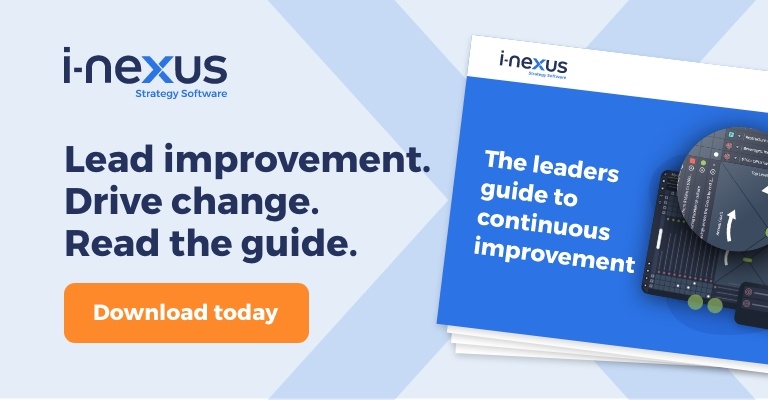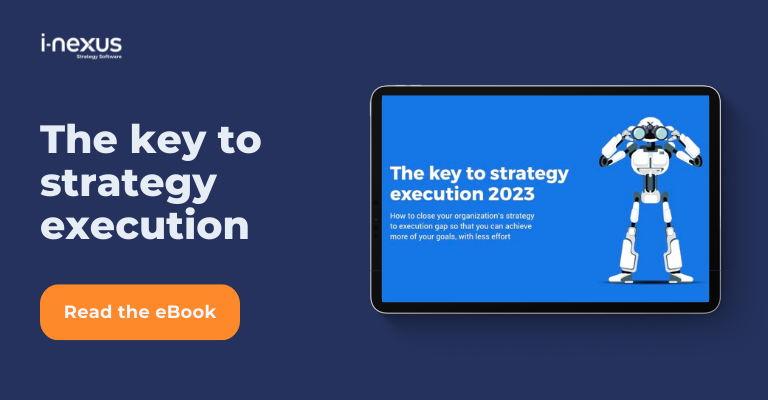Total Quality Management (TQM) is a customer-focused approach to improving the value of your products and services. Find out what the eight principles underpinning TQM are in our blog.
What is total quality management?
TQM is a management system for a customer-focused organization that involves all employees in continual improvement, using strategy, data, and effective communications to integrate quality discipline into the culture and activities of the organization.
Read on to discover the eight principles of TQM and how they support your organization to create a robust, effective system to improve your customers' experience.
1. Customer-focused
Customers are essential because they are the ones who use and benefit from the products or services a company provides.
Their wants and needs reflect what customers value and look for in a product or service and, therefore, the quality of the product and service.
By understanding and prioritizing the wants and needs of customers, a company can ensure that its products or services are of high quality and meet the needs of its target market.
This is important because when a company delivers high-quality products or services that meet the needs of its customers, it can increase customer satisfaction and loyalty, leading to increased sales and long-term business success.
Becoming customer-focused
How to implement this TQM principle:
- Understand your customers by researching them, creating buyer personas that define their needs and expectations - grouping people by job title/product, and interviewing these customers to conclude.
- Take the results from research to create new goals, processes, and measurements which align strategic and operational objectives to customer needs.
- Introduce systems such as NPS (Net Promoter Score) or CSAT (Customer Satisfaction Score) to gauge customer satisfaction and areas to improve, feeding this into efforts to change processes, eliminate waste, and keep your customers delighted.
- Continuously monitor and improve customer relationships, using customer value maps to prioritize your most valuable relations.
- Use a prioritization matrix and stakeholder management to balance competing needs between your customers, employees, shareholders, suppliers, regulators, and beyond.
The benefits of being-customer focused
There are many benefits to being customer-focused. Some of the main benefits include:
- Increased customer satisfaction
By focusing on the needs and preferences of customers, a business can improve the overall customer experience and increase customer satisfaction. - Improved loyalty
When customers feel that a business values them and their needs, they are more likely to become loyal to the brand and continue doing business with the company. - Positive word-of-mouth
Happy customers are likelier to tell their friends and family about their positive experiences with a business, which can help attract new customers. - Increased sales and revenue
A business can increase its sales and revenue by focusing on customer needs and providing excellent service. - Competitive advantage
A customer-focused business is more likely to stand out in a crowded market and differentiate itself from its competitors. - Improved business performance
A customer-focused business is more likely to have a strong reputation and be successful in the long term.
2. Complete employee involvement
The key to achieving any goal is for employees to invest in their work thoroughly. This means creating a workplace where fear is not a factor and employees are empowered to take ownership of their roles.
To approach a TQM mindset, it is essential to implement thorough planning and management systems that integrate continuous improvement with daily work, and enable a constant loop of feedback to identify and overcome areas of poor quality.
How to get your employees engaged
To implement this TQM principle:
- Start by mapping out different messages for stakeholders in your organization - the message must reflect why everyone needs to contribute to increasing quality.
- Introduce systems that allow employees to engage with goals designed to support improvement, all the while providing tools to capture ideas for change, and a means to evaluate and then reward these.
- Offer ample chances to your team to upskill in areas around Lean, Six Sigma, Kaizen, and beyond - ensuring that they have the means and methods to impact quality.
- Promote the opportunity for your teams to work across departments, shadow team members, and attend Gembas and Kaizens.
- Build and maintain a learning culture where problems are shared, solutions are created, and everyone takes ownership of spreading this throughout the organization.
The benefits of improving employee engagement
Some of the benefits of improving employee engagement include:
- Increased productivity
Engaged employees are more likely to be motivated, focused, and productive. This can increase efficiency and output in manufacturing plants and production lines. - Higher quality work
Engaged employees are more likely to pay attention to detail and produce higher-quality work. This can lead to fewer defects and rework, saving the company time and money. - Innovation
Working collaboratively encourages teams to work together and be exposed to ideas and problem-solving approaches from which they may be hidden. - Lower turnover
Engaged employees are more likely to be satisfied with their jobs and less likely to leave the company. This can help to reduce the costs associated with recruiting and training new employees. - Improved safety
Engaged employees are more likely to be aware of their surroundings and follow safety protocols, which can help to reduce accidents and injuries in a manufacturing plant and production environment. - Greater customer satisfaction
Engaged employees are more likely to provide excellent customer service, which can lead to increased customer satisfaction and loyalty.
3. Process-centered
A fundamental part of TQM is a focus on process thinking. A process is a series of steps that take inputs from suppliers (internal or external) and transform them into outputs delivered to customers (internal or external).
The steps required to carry out the process are defined, and performance measures are continuously monitored to detect unexpected variations.
Well-defined steps and performance metrics allow for identifying variations that can be addressed to improve quality results.
How to become process centered
You can implement this TQM principle with:
- Total Quality Management tools such as the Ishikawa diagram, pareto charts, and value stream mapping to define roles, responsibilities, and areas to focus quality improvement projects.
- An x-matrix to join quality projects to your operational excellence portfolio and your strategy - showing how projects, resources, and metrics lead to your goals.
- A bowling chart and root cause analyses to analyze and measure your quality projects, helping you to understand the changes and improvements in your processes and hypothesize solutions to bottlenecks.
- Evaluate the impact of your processes and activities by visualizing the effect and benefits, considering your outcomes - process - and balancing measures.
The benefits of being process minded
By focusing on the processes and systems within an organization to improve efficiency, quality, and overall performance, organizations benefit from:
- Increased efficiency
By focusing on processes and systems, an organization can identify inefficiencies and find ways to streamline its operations. This can lead to increased productivity and cost savings. - Improved quality
By establishing transparent processes and protocols, an organization can ensure that work is completed consistently and to a high standard. This can lead to fewer errors and defects and improved customer satisfaction. - Greater control
By having well-defined processes in place, an organization can have greater control over its operations and be better prepared to handle unexpected situations. - Enhanced collaboration
Process-minded organizations often have clearly defined roles and responsibilities, which can facilitate better communication and collaboration among team members. - Increased innovation
A process-minded organization can foster a culture of continuous improvement and drive innovation by encouraging employees to question and improve existing processes. - Improved risk management
By having robust processes in place, an organization can better identify and mitigate potential risks to its operations.
4. Integrated system
To reach its full potential, an organization must create and maintain interconnected processes across departments.
Everyone needs to be on the same page regarding mission statements and procedures while staying attuned to performance indicators - only then can strategic objectives be achieved.
Quality at every level is paramount for success; by keeping a sharp eye on key operations, long-term goals have increased chances of realization.
An effective business system can make the difference between success and failure for an organization, such as Danaher's Business System. Creating a structure that incorporates elements of excellence is essential.
By establishing a culture rooted in learning and quality assurance, organizations will have better access to the tools needed to continually outperform customer expectations while engaging employees and other stakeholders with meaningful improvements that drive strategic goals.
How to create an integrated system
To implement this TQM principle:
- Make sure that everyone at work is focused on doing a good job.
- Use pictures and other visual aids to help employees see how their jobs fit with the rest of the company.
- Look at how you are doing things now to see where you can improve.
- Ensure employees have the chance to learn new processes and explore ways to advance in their careers.
The benefits of an integrated system
With an integrated system in place, organizations typically benefit from:
- Improved efficiency
Interconnected processes allow different departments to work together in a coordinated way, which can help to streamline operations and reduce the risk of bottlenecks or other issues that can slow down progress. - Enhanced collaboration
Interconnected processes encourage employees from different departments to work together and share information, which can foster a culture of collaboration and cooperation within the organization. - Increased transparency
When processes are interconnected, it can be easier for employees to see how their work fits into the larger context of the organization's operations. This can help to increase transparency and improve communication. - Better decision-making
Interconnected processes can provide a complete picture of an organization's operations, which can help decision-makers make informed decisions that consider the impact on multiple departments. - Greater agility
By design, interconnected processes are more flexible and adaptable than siloed processes. This can enable an organization to respond more quickly to market or business environment changes.
5. Strategic and systematic approach
Linking to the need for an integrated system, organizations must have operational excellence as part of their approach to strategy execution.
Whether it is a feature on a balanced scorecard, a strategic portfolio, or a breakthrough objective on an x-matrix, improving quality should be given appropriate focus, resources, tools, and support from across the business.
How to implement a strategic and systematic approach
To implement this TQM principle:
- Ensure you have fully explained the system and how it interconnects in terms of work, people, and processes
- Train your team, leaving them with the tools and resources needed to support quality improvement
- Take every day as a learning opportunity - ideally with a value stream map as a starting point - to identify how to improve processes, products, equipment, and more to ensure you deliver value to your customers.
- Integrate quality into your performance management approach, ensuring your team is recognized and rewarded for individual and collective efforts.
The benefits of having this approach:
Ensuring you have a strategic and systematic approach ensures:
- Quality work drives strategic goals
A well-defined approach ensures that you can connect the daily work of quality and improvement to the organization's strategic goals and ultimately back to the most important stakeholder - your customer. - Scalability
The likes of Danaher have succeeded with their system because it allows you to gradually roll out the approach, refining and improving how you support quality efforts so that you're always changing with the challenges that come from daily operations.
6. Continuous improvement
Quality sits within the world of operational excellence; therefore, you can gradually increase quality rates by making minor daily improvements.
This approach allows you to be flexible and adaptable with the areas of your products and services you seek to improve.
Click here to learn more about operational excellence and here for the benefits of improvement.
7. Fact-based decision-making
For TQM to be successful, it requires a bedrock of data. If you have ineffective or non-existent data collection in your organization and struggle to get meaning out of data, you will struggle with driving quality.
Therefore, making data collection and entry a standard part of daily work is a critical element of TQM. With this, you can enable fact (and data) based decision-making.
How to be a fact-based decision-maker
To implement this TQM principle:
- Explain the importance of data in improving the customer's experience
- Introduce an easy-to-replicate approach to collecting/entering data for your team, such as i-nexus.
- Create systems to prompt the entry of data, as well as identify any errors in the data.
- Share the right data with the right stakeholders.
- Lead decisions by looking at information and reaching a conclusion that balances the data with your team's experience and knowledge of their markets, roles etc.
The benefits of using data for decision-making:
Being a data-driven decision-maker can bring several benefits, including:
- Increased objectivity
Data-driven decision-making relies on factual evidence rather than personal opinions or biases. This can help to make decision-making more objective and ensure that decisions are based on sound reasoning. - Enhanced accuracy
Data-driven decision-making can help to reduce the risk of errors or mistakes, as decisions are based on hard evidence rather than guesses or assumptions. - Improved efficiency
Data-driven decision-making can help to streamline decision-making processes, as data can be easily accessed and analyzed to inform decisions. - Greater accountability
Data-driven decision-making leaves a clear trail of evidence, which can help to increase accountability and ensure that decisions can be defended and justified. - Enhanced credibility
Data-driven decision-making can help increase an organization's credibility, demonstrating a commitment to evidence-based decision-making. This can be particularly important when dealing with external stakeholders, such as customers or regulators.
8. Effective communications.
Effective communication is an integral component of organizational TQM success. From managing change to day-to-day operations, clear and timely messages can inspire motivation among employees while also maintaining morale.
A successful communications strategy involves utilizing appropriate methods delivered at the right time for maximum effect.
To learn more about effective communication to drive success, download a copy of our How to lead Hoshin Kanri eBook.
How to be a good communicator
To implement this TQM principle:
- Analyze stakeholders
Complete a stakeholder analysis to understand the different motivations of your stakeholders - Scene set
Communicate a future where you’ve achieved your goal, the role that teams play in getting there, and what they’ll feel once they’ve reached this exciting future - Define the obstacle
Work collaboratively in workshops and meetings to unearth the obstacles and what needs to change to reach that future. - Give a solution
Create solutions to overcome these obstacles, and bring it all back to the future – use this as a springboard for how you’ll move into execution.
The benefits of good communication
Good communication can bring several benefits to an organization, including:
- Improved efficiency
Good communication can help to ensure that employees have the information they need to do their jobs effectively, which can help to streamline operations and increase productivity. - Enhanced collaboration
Good communication can foster a culture of teamwork and collaboration, enabling employees to share ideas, collaborate on projects, and work together more effectively. - Increased transparency
Good communication can help increase transparency within an organization, enabling employees to share information and stay informed about what is happening within the organization. - Better decision-making
Good communication can help improve decision-making quality, as it enables employees to share information and perspectives that may not have been considered otherwise. - Greater employee engagement
Good communication can help to increase employee engagement, as it enables employees to feel informed and included in decision-making processes. This can help to build trust and strengthen the relationship between employees and management.
How to adopt a Total Quality mindset
Total quality management is a comprehensive approach to improving your organization's performance.
It starts with the right mindset and implementation of systems that drive quality. The eight principles of TQM provide a foundation for achieving operational excellence and delivering the most significant possible value to your customers.
Download our guide today to learn more about implementing these methods in your organization.
Learn more about operational excellence
Take the next steps in your journey by exploring our operational excellence resource hub or any of the below:
- Key to strategy execution eBook: Read how companies like Danaher and HP have mastered strategy execution and what you can learn from them.
- What does it mean to be Business Agile?: Leap into the future of strategic planning and execution with this fascinating insight.
- How AI and Machine-Assisted Learning will help strategy execution: As Artificial Intelligence becomes a mainstay in our lives, read how AI and machine-assisted learning will evolve to support your strategy execution.
About the author
James Milsom is Head of Marketing at i-nexus.
As Head of Marketing, his drive is to raise awareness and understanding of enterprises' challenges in delivering strategic goals amidst changing markets and the obstacles traditional tools and methods present leaders.
If you’d like to talk more about strategy, reach out to James on james.milsom@i-nexus.com or connect with him on LinkedIn for the latest insights.






